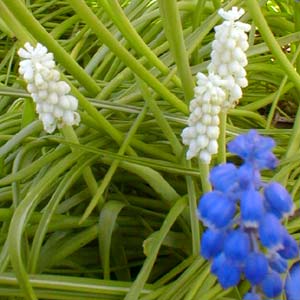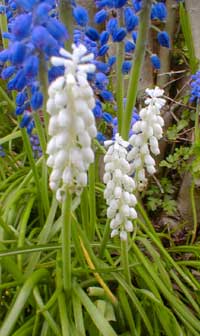
Pearls of Spain; aka,
White Grape Hyacinths
"Courage is not the towering oak
that sees storms come and go;
it is the fragile blossom
that opens in the snow."
-Alice Mackenzie Swaim
(1911-2000)
(1911-2000)
The regular blue Muscari botryoides has such a reputation for weediness when it is good & naturalized that many people refuse to plant it, & many bulb specialists have ceased to offer it. In reality many of the other species are just as "bad" but only M. armeniacum has anything resembling M. botryoides' reputation for spreading rather too easily.
Personally I've never minded that the species is slightly rampant. The normal blue form has been naturalized in our yard apparently for decades, since ages before we bought the house at any rate, yet it had mainly colonized one extensive area where it is perfectly welcome. When they do pop up more distantly, they're easy to remove.
When I have had to dig around in the garden or move soil, I've been careful not to move soil from around the grape hyacinths to any location where grape hyacinths wouldn't be wanted, as the tiniest bulblets can never really be removed from that soil. I find them to be manageable overall, & the beauty of their long-naturalized presence induced Granny Artemis & myself to plant many additional species & varieties here & there around the gardens, as they're simply so rewarding.
 But for anyone who disagrees with me that they are never seriously a burden, the white form often sold as "Pearls of Spain" does not share the reputation of the regular blue. It certainly does naturalize nicely, but never aggressively.
But for anyone who disagrees with me that they are never seriously a burden, the white form often sold as "Pearls of Spain" does not share the reputation of the regular blue. It certainly does naturalize nicely, but never aggressively.There was a partially "bare spot" amidst the naturalized blues, so I dressed up that soil a bit, & planted Showy Autumn Crocus (C. speciosus ssp speciosus) plus "Pearls of Spain" in the bare spot. Because these muscaris produce lots of lily-turf in autumn, they provide the sorely needed braces for the Showy Autumn Crocus which has a horrifying tendency to fall over on its side as soon as it blooms if something thick & grassy isn't present to hold up the crocus flowers. The muscari turf is showing itself by early September, & the autumn crocuses are blooming by late September & all through October. The crocuses are usually still blooming even into November, by far the longest-lasting of the fall crocuses. Of the companions I've tried for these floppy crocuses, nothing has worked as well as the M. botrkyoides' autumn turf.
Though many of the long-naturalized blues have their bulbs sticking above the soil, when planting autumn bulbs they should be sunk to six inches depth, & crocus bulbs can be set three inches deep right above them. So I went ahead & added the Pearls of Spain amidst what had previously been only blue Grape Hyacinths, with the crocus bulbs layered at a shallower point in the soil.
The muscaris though grassy in autumn do not bloom until spring, & this spot where previously spring flowering was dominated by blues, there's now a little drift of whites mixed through. White & blue are bound to cross-pollinate, so the Pearls of Spain will not seed true, but they will produce bulblets, & those will thicken up the section of pure white grape hyacinths.
The blue grape hyacinths are in full flower & swollen to maximum size by the end of March, but the Pearls-of-Spain are a bit slower. At the end of March the blooms are still only about half their ultimate size. Some small ones are shown in the March-end photo above, still some ways from catching up with the blues. The second photo shows them a couple weeks later in April.
Pearls of Spain likes full sun in the morning or afternoon, but not both. It needs moist well draining soil autumn & spring, but is completely drought hardy during summer dormancy.
Like the majority of species & varieties of grape hyacinths, Pearls of Spain needs a chilly winter (close to freezing in winter, but not much colder than 30 or 32 Fahrenheit) & a warm period in spring (in the fifties & sixties Fahrenheit) followed by a droughty summer dormancy & wet autumn. This provides a "thermoperiodic cycle" conducive to production of bulb offsets. It can be grown in less optimal conditions but will not be as inclined to spread in zones where the changing seasons are not sufficiently detectible.
Flowers last into May, little flower-bunches rising to only six or eight inches in height. Sometimes "Album" is fragrant, but not reliably, & never as boldly redolent as M. muscarimi.